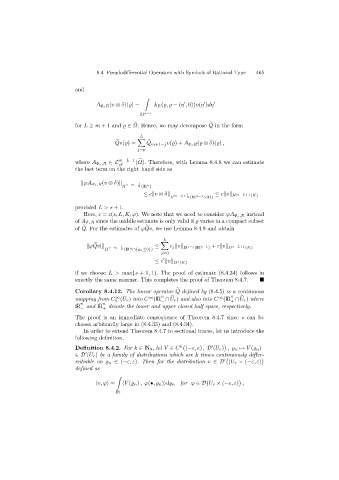Page 481 -
P. 481
8.4 Pseudodifferential Operators with Symbols of Rational Type 465
and
A Φ r R (v ⊗ δ)( )= k R , − (η , 0) v(η )dη
IR n−1
for L ≥ m +1 and ∈ Ω. Hence, we may decompose Q in the form
L
Qv( )= Q m+1−j v( )+ A Φ r R ( ⊗ δ)( ) ,
j=0
(Ω). Therefore, with Lemma 8.4.8 we can estimate
where A Φ r ,R ∈L m−L−1
c
the last term on the right–hand side as
ϕA Φ r ,R (v ⊗ δ)
s−m− 1
n
H 2 (IR )
≤ c
v ⊗ δ
m−L+ 1 ≤ c
v
H m−L+1 (K)
H 2 (IR n−1 ×IR)
provided L>s +1.
Here, c = c(s, L, K, ϕ). We note that we need to consider ϕA Φ r ,R instead
of A Φ r R since the middle estimate is only valid if varies in a compact subset
of Q. For the estimates of ϕQv, we use Lemma 8.4.9 and obtain
L
ϕQv
| s−m− 1 ≤ c j
v
H s−j (IR n−1 + c
v
H s−L+1 (K)
)
n
H 2 (IR ∩{ n ≤0})
j=0
≤ c
v
H s (K)
if we choose L> max{s +1, 1}. The proof of estimate (8.4.34) follows in
exactly the same manner. This completes the proof of Theorem 8.4.7.
Corollary 8.4.12. The linear operator Q defined by (8.4.5) is a continuous
n
n
∞ ¯
∞ ¯
∞
mapping from C (U r ) into C (IR ∩U r ) andalsointo C (IR ∩U r ) where
0
+
−
¯
¯
IR n and IR n denote the lower and upper closed half space, respectively.
− +
The proof is an immediate consequence of Theorem 8.4.7 since s can be
chosen arbitrarily large in (8.4.33) and (8.4.34).
In order to extend Theorem 8.4.7 to sectional traces, let us introduce the
following definition.
Definition 8.4.2. For k ∈ IN 0 ,let V ∈ C k (−ε, ε) , D (U r ) , n → V ( n )
∈D (U r ) be a family of distributions which are k times continuously differ-
entiable on n ∈ (−ε, ε). Then for the distribution v ∈D (U r × (−ε, ε)
defined as
v, ϕ = V ( n ) ,ϕ(•, n ) d n for ϕ ∈D U r × (−ε, ε) ,
IR

